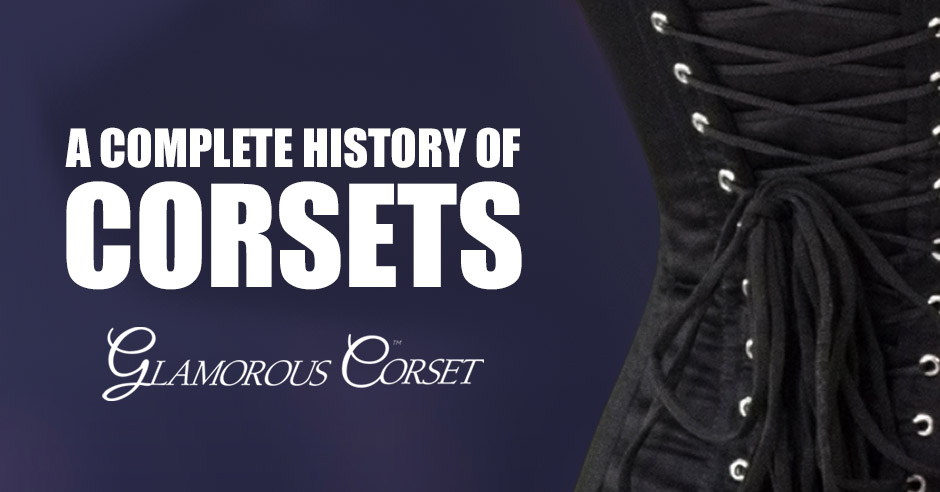Blog
A Complete History of Corsets: Starting in the 16th Century
Corsets have been around for several centuries. So where did the history of corsets begin and how did they come about?
16th Century
It all started in the 16th Century in Italy. The first true corset was invented. At this time, corsets were not worn for the purpose of achieving a cinched waist and hourglass shape. Instead, it was designed to mold the torso into a cylindrical shape, and to flatten and raise the bustline. During this period, corsets were usually worn with a farthingale that held out the skirts in a stiff cone. The corsets turned the upper torso into a matching but inverted cone shape. Corsets are made out of rigid materials such as whalebone, horn, and buckram and are referred to as “whalebone bodices”. A stay more commonly known today as a busk, which is placed vertically in the center of the torso to keep it straight. Typically the busk was made of wood, horn, ivory, metal, or whalebone, was added to stiffen the front of the bodice. It was then carved and shaped into a thin knife shape and inserted into the Elizabethan bodice, then fastened and held into place by laces, so that the busk could be easily removed and replaced. Since the mid-Victorian period, the busk has been made of steel and consisted of two parts, one for each side. One side has studs and the other eyes so that the corset can be easily fastened and unfastened from the front. During the late 1500s, when whalebone was used at the sides and back of the corset, the corset was laced up at the front. Eventually, the lacing came to be done at the back of the corset.
These corsets were typically made out of layered fabric, stiffened with glue, and were tightly laced. Usually worn with shoulder straps, the corset extends the length of the torso, stopping just above the pelvic bone. Catherine de Medici (1519–1589) is credited with introducing corsets to France where women of the French court embraced it.
By the middle of the sixteenth century, corsets have become very common among European and British women.
17th Century
The 17th Century corset shared many similarities from the previous century. While the origin of the corset lies in the mid 1500’s, popularity of the corset spreads by the Royal Courts of Europe. By the middle of the century most women wore corsets. From about 1740, an important aspect of a corset during this period was the stomacher. Which was a long V or U shaped panel that decorated the front of a corset extending from her neckline down to the waist, sometimes even below the waist. The bodice’s lacings would then criss-cross over the stomacher, and eventually the lacings became a series of decorative bows. Stomachers were often embroidered, or covered in pearls and other jewels. They could be made of the same fabric as the dress or of a contrasting fabric. Necklines also defined the length of a stomacher. There was a brief period during the court of Louis XVI, when the neckline and stomacher actually were below the breasts, which were covered by a transparent ruffle of fabric called a fichu. The nipples could then be rouged or even pierced and decorated with pearls or other gemstones.
18th Century
The most common type of corset in the 1700s was an inverted conical shape, it was meant to create a contrast between the cylindrical torso above the waist and heavy full skirts below. The primary purpose of 18th-century stays was to raise and shape the breasts, tighten the midriff, support the back and improve posture.
Shoulders are intended to be down and back, slightly narrowing the waist, which created a “V” shaped upper torso over which the outer garment would be worn.
Well-fitting eighteenth-century corsets were know to be very comfortable, allowed women to work and did not restrict breathing, They did restrict bending at the waist, forcing one to protect one’s back by lifting with the legs.
Around 1796 corsets became less constricting with the introduction of the high waisted empire style which de-emphasized the natural waist. Some form of corset was still worn by most women of the time but these were often “short stays” (i.e. they did not extend very far below the breasts). By contrast, corsets intended to exert serious body-shaping force (as in the Victorian era) were “long” (extending down to and beyond the natural waist), laced in back, and stiffened with boning.
19th Century
By 1800’s, the corset had become primarily a method of supporting the breasts, as the waist was raised to just under the bust line. Corsets still slimmed the torso but this was no longer their main role. During the 1830s, the waistline has returned to its natural position, the corset now serves the dual purpose of supporting the breasts and narrowing the waist. The corset shape has now changed to the hourglass silhouette which is still sought out in today’s corsets and Victorian fashion. In 1839, a Frenchman by the name of Jean Werly made a patent for women’s corsets made on the loom. This type of corset was popular until 1890 when machine-made corsets gained popularity. Before this, all corsets were typically made at home and were off-course handmade.
Victorian Corset
During the Victorian era, mid to late 19th Century it was all about the hourglass figure, all focus was on creating a tiny waist. In the1840s and 1850’s tight-lacing first became popular. The corset was very different from before in several ways. The corset no longer ended at the hips, but flared out and ended several inches below the waist. The corset was exaggeratedly curvaceous rather than funnel-shaped. Spiral steel stays curved with the figure. While many corsets were still sewn by hand to accommodate the wearer’s measurement, there was also a thriving market in cheaper mass-produced corsets.
During the late 19th century tight-lacing has raised some concerns. Some doctors supported the theory that corset may cause health injuries, specifically during pregnancy and women who practiced tight-lacing were looked upon as slaves to fashion.
In reality, tight-lacing was most likely the cause of indigestion and constipation but rarely the cause for a plethora of ailments associated with tight corseting at the time ranging from hysteria to liver failure.
In part as a response to the perceived dangers of tight-lacing, but also due to women’s increasing interest in outdoor activities, “health corsets” became popular during the late 19th century. In 1884, A German physician, Dr. Gustav Jaeger (1832-1917) came up with wool sanitary corsets, described as flexible and elastic. They were also durable and respondent to movements. Dr. Jaeger claimed that the wool had curing capabilities and that it had cured him of his chronic health problems: excess of weight and indigestion. Another was created in 1887, a dermathistic corset with leather facing. It was marketed towards women who wanted better health and enjoyed a vigorous lifestyle.
Edwardian Corset
From the 1900’s to early 1910’s the straight front corset came about, also known as the swan bill corset, the S-bend corset or the health corset. Its name comes from the very rigid, straight busk in the center front of the corset. This corset forced the torso forward and made the hips jut out in back.The straight-front corset was a favorite of Inez Gaches-Sarraute, a corsetierre with a degree in medicine. This corset was meant to be less injurious to wearers’ health than other corsets in that it exerted less pressure on the stomach area. However, any benefits to the stomach were more than counterbalanced by injury caused to the back due to the unnatural posture that it forced upon its wearer. At this time, the bust lowered and corsets provided much less support for the breasts. By 1908 the silhouette changed to a higher waistline and more naturalistic form. Early forms of brassieres were introduced and the girdle soon took the place of the corset which was more concerned with reducing the hips rather than the waist.
20th Century
From 1920’s to 1950’s corset lost their popularity. Fashion has permitted woman to wear dresses and other garments without a corset. Corsets were still worn but by few but. They were now replaced by girdles. Girdles were not focusing on the waist, they were meant to control the stomach and hips, they were elastic and not restricting.
Before becoming a mass fashion trend, Vivienne Westwood was the first designer of the twentieth century to reinvent the corset in the mid-1970s. One of her most important fashion ideas, they quickly become a signature theme in her work. Modeled from those of the eighteenth century, her corsets flattened and raised the bosom, giving women a unique sense of power and glamour.
In the 1960’s and 1970’s it was Christian Dior’s new style that brought back the focus on the “waist”. His models emphasized an extremely small waist and wide hips setting a trend in the fashion world.
During the early 1990’s Madonna famously wore fashion designer Jean Paul Gaultier’s corset during her world tour in 1990. Known for his extreme fashions, Gaultier designed Madonna’s memorable one of a kind pink corset with a built in cone bra. This launched a huge trend and empowers women till today.
Today
Corsets serve many purposes today and are very popular amongst both women and men. The most common use of corsets is to reduce the waist, which exaggerates the bust and hips which in turn creates an hourglass silhouette Over the last decade, waist training and tight-lacing have become a growing trend. Corsets can also be used for medical reasons. People with spinal problems, such as scoliosis, or with internal injuries, may be fitted for a corset. Those who suffer from back pain may use corsets for support. Posture problems? Corsets can help with improving posture too. Transgender community has recently become active with wearing corsets. Corsets can also be worn as part of costume, simply for fashion, on stage for a performance or for a theatrical production, for sexual fetishism or for some good old bedroom fun.
We sometimes ask our customers what they like most when you have their corset on, and most give the same answer: “Corsets give an amazing sense of empowerment. And that’s a wonderful feeling!”
Whatever you purpose for wearing a corset, enjoy it and if you have any questions, please don’t hesitate to contact us. Our experts are available to answer all your questions!

My name is Rachel, I am the owner of Glamorous Corset, a small business founded by me in 2010. Back In 2005, I was in a car accident that left me with a herniated disk. Much to my surprise I learned steel boned corsets were beneficial to several medical injuries including mine. I was always intrigued with corsetry, their history and their beautiful aesthetic. I love sharing knowledge about corsets, educating my wonderful readers and breaking the negative stigma related to corsetry. In combination with my years of research and personal experience I hope my articles are useful and can help anyone who has struggled with some of the same things I have. More about me…


